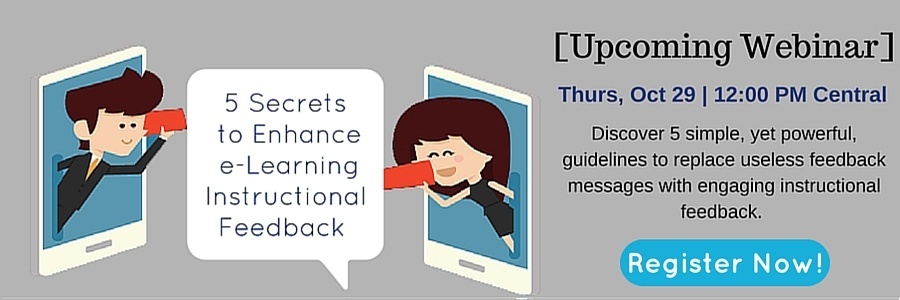Blog
3 Reasons To Attend ATD's E-Learning Instructional Design Training
By Ethan Edwards, Chief Instructional Strategist / @ethanedwards The feedback in your interactions might be the most critical element contributing to ...


5 Powerful Ways to Improve Instructional Feedback in Your e-Learning Designs
By Ethan Edwards | October 22, 2015 | Custom Learning | 0 Comments
By Ethan Edwards, Chief Instructional Strategist / @ethanedwards
 The feedback in your interactions might be the most critical element contributing to the effectiveness of your elearning designs. Context, challenge, and activity engage the learner by communicating relevance, activating prior knowledge, elevating motivation, and engaging learners through meaningful gestures, but it is in the feedback where teaching and learning meet.
The feedback in your interactions might be the most critical element contributing to the effectiveness of your elearning designs. Context, challenge, and activity engage the learner by communicating relevance, activating prior knowledge, elevating motivation, and engaging learners through meaningful gestures, but it is in the feedback where teaching and learning meet.
Too often, feedback is tossed off with little thought, little more than a useless “No, try again” message which is almost worse than useless in any benefit it offers the learner. Instead, the feedback should be the “payoff.” You might even say that the whole point of an e-learning interaction is as a vehicle to deliver feedback.
But how do you create effective feedback?
Here are the top 5 strategies I use to design really effective and impactful instructional feedback:

1. Present feedback in context
Feedback must be completely integrated into the context. In fact, in thinking of options for your context, the principle consideration in evaluating the most effective context among alternatives is the extent that it facilitates the delivery of feedback. What is the point of creating a vivid immersive visual context if you abandon the illusion of relevance at the exact moment of critical importance.
2. Load feedback with content
One of the biggest obstacles to meaningful content delivery is motivating learners to read content for meaning. Too often, reading is simply skimmed or entirely skipped. But the moment of most heightened interest is after you have motivated the learner to act based on a meaningful challenge—that’s when you have the learner’s attention to deliver a meaningful content message.
3. Provide lots of immediate feedback, but delay judgment
Feedback is a reflection back to the learner of the effectiveness of the learner’s response. Judgment, on the other hand, is a concluding assessment of performance. Feedback begets critical thinking that leads to active learning. Judgment shuts down curiosity and fosters passive resignation.
4. Provide intrinsic feedback
Intrinsic feedback is the practice of communicating outcomes not through independent messaging but rather through indicators embedded in the actual contextual learning environment. Intrinsic feedback takes the ideas that drive simulations and heightens the degree to which successes and failures are clearly communicated. Good intrinsic feedback supports transfer of new behaviors from the learning environment to the performance environment.
5. Communicate through consequences
Correctness is not necessarily a particularly potent or even interesting indicator of success. As learners we care much more—particularly if we have been appropriately engaged through a compelling challenge—about the actual consequences of our choices. Actual real-life rewards or painful results create meaningful and emotional memories to reinforce learning.
Try these strategies for the next e-learning interactions you design. I think you’ll be surprised how even a little creative focus on this often overlooked element of interactivity can radically transform the impact of your work.
And I you want to learn even more about these 5 strategies for improving your instructional feedback in e-learning course designs, consider attending my upcoming webinar on this topic on Thursday, October 29th! LEARN MORE & REGISTER
LIKE WHAT YOU'VE READ? SHARE THE KNOWLEDGE WITH THIS READY-MADE TWEET!
CLICK TO TWEET: 5 Powerful Ways to Improve Instructional #Feedback in Your #eLearning Designs http://hubs.ly/H01jPX10

About the Author: Ethan Edwards
Ethan Edwards draws from more than 30 years of industry experience as an elearning instructional designer and developer. He is responsible for the delivery of the internal and external training and communications that reflect Allen Interactions’ unique perspective on creating Meaningful, Memorable, and Motivational learning solutions backed by the best instructional design and latest technologies.
Comments
Would you like to leave a comment?
Related Blog Posts

By: Ethan Edwards | Jul, 2015
Category: Custom Learning

Blog
5 Lessons for Designing Engaging e-Learning Interactions from Project Runway
By Ethan Edwards, Chief Instructional Strategist / @ethanedwards The feedback in your interactions might be the most critical element contributing to ...
By: Ethan Edwards | Jan, 2016
Category: Custom Learning

Blog
Achieving a Bountiful e-Learning Harvest
By Ethan Edwards, Chief Instructional Strategist / @ethanedwards The feedback in your interactions might be the most critical element contributing to ...
By: Ethan Edwards | Nov, 2015
Category: Custom Learning, Strategic Consulting


